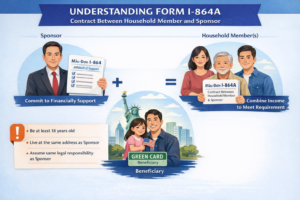Under U.S. immigration law, Adjustment of Status (“AOS”) refers to the process through which an individual who is already in the United States applies to change their immigration status from that of a nonimmigrant visa status to that of an immigrant visa status, or “Lawful Permanent Residence”. This process is typically pursued by individuals who entered the U.S. legally on a temporary basis as a nonimmigrant and later decide to stay permanently. One of the best examples is when a student on F-1 status to attend a four year bachelor degree program is offered a job and qualifies at the end of their studies. They may then be eligible for Adjustment of Status.
All AOS Applicants must fulfill certain qualifying requirements in order to apply for Adjustment of Status. They must have entered the U.S. lawfully, such as with a valid nonimmigrant visa and be physically present in the United States at the time of filing the application. It is also crucial that they have not overstayed or violated any other visa restrictions. The applicant must also be the recipient of an authorized immigration petition, usually one that is based on employment, investment or family.
There are a number of crucial steps in the AOS application process. A Form I-485, Application to Register Permanent Residence or Adjust Status, must be submitted to U.S. Citizenship and Immigration Services (“USCIS”) as the initial step. Following submission, the applicant will usually need to attend a biometrics appointment in order to have their fingerprints taken. In order to make sure they are not ineligible for health-related reasons, applicants must also submit a medical exam report from a USCIS approved physician. Sometimes a face-to-face interview with a USCIS officer is necessary. Ultimately, USCIS will determine whether to approve or refuse the application after reviewing it and all supporting documentation.
One of the primary advantages of AOS is that applicants are permitted to stay in the U.S. during the processing of their application and do not need to interview at a U.S. Consulate or Embassy abroad. Applicants can also apply for work authorization by filing a Form I-765, which would enable them to work lawfully in the United States during the pending AOS application. Furthermore, while an AOS application is pending, applicants can request permission to travel outside the U.S. for urgent travel by filing Form I-131.
For some employment and family-based immigrant visa categories, applicants must wait for a visa number to become available before submitting their AOS application. If you have questions about the AOS process, contact us at info@enterlinepartners.com.
ENTERLINE & PARTNERS CONSULTING
Ho Chi Minh City, Vietnam Office
146C7 Nguyen Van Huong St, Thao Dien Ward,
District 2, Thu Duc City
Ho Chi Minh City, Vietnam
Tel: +84 933 301 488
Email: info@enterlinepartners.com
Facebook: Enterline & Partners – Dịch vụ Thị thực và Định cư Hoa Kỳ
YouTube: @EnterlineAndPartnersConsulting
Website: http://enterlinepartners.com
Manila, Philippines Office
LKG Tower 37th Floor
6801 Ayala Avenue
Makati City, Philippines 1226
Tel: +63 917 543 7926
Email: info@enterlinepartners.com
Facebook: Enterline and Partners Philippines
Website: https://enterlinepartners.com/language/en/welcome/
Copyright 2025. This article is for information purposes only and does not constitute legal advice. This article may be changed with or without notice. The opinions expressed in this article are those of Enterline & Partners only.




